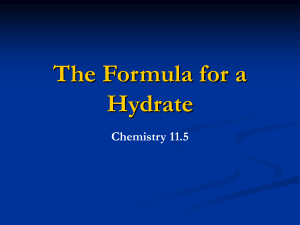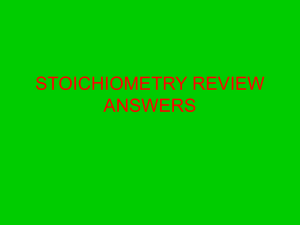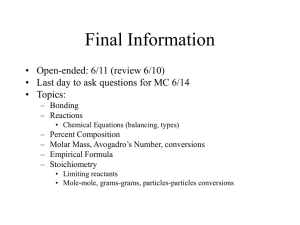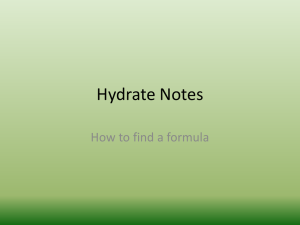Moles and Stoich - Tri
advertisement
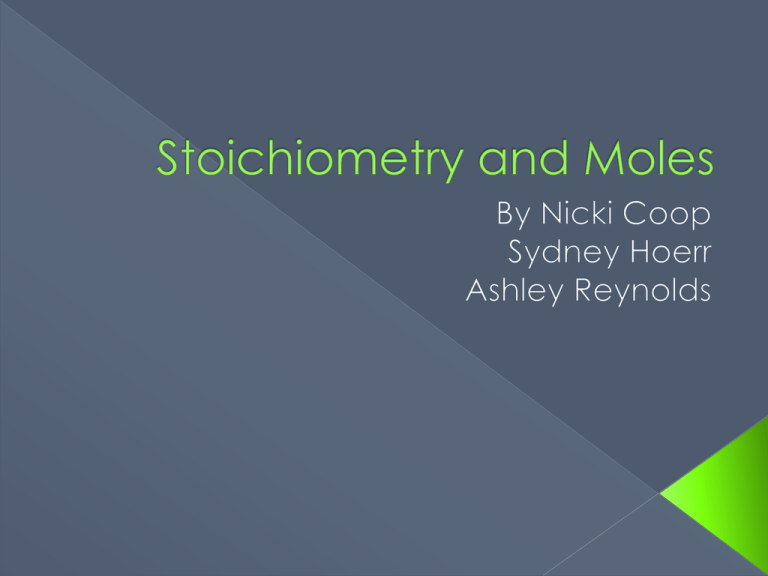
Atomic Number › Number of protons found in the nucleus of the element. Mass Number › The number of protons and neutrons in a given element. Atomic Mass › The total mass of the protons, neutrons, and electrons in the element without being an ion or isotope. Mass Number Atomic Number Atomic Mass Empirical Formula › is the reduced version of the formula A compound was analyzed and found to contain 13.5 g Ca, 10.8 g O2 and 0.675 g H. What is the empirical formula? 13.5 g Ca /40.08 MM Ca = 0.337 mol Ca 10.8 g O / 16 MM O = 0.675 mol O 0.675 g H / 1.01 MM H = 0.668 mol H › Divide by the smallest 0.337 mol Ca / 0.337 = 1 0.675 mol O / 0.337 = 2 0.668 mol H / 0.337 = 2 › Answer: CaO2H2 Molecular Formula › All the atoms in a formula The simplest formula for vitamin C is C3H4O3. If the molecular mass of vitamin C is 180, what is the molecular formula? Calculate the atomic mass of the empirical formula. › MM = 88.07 Divide the molecular mass from the molar mass › 180/88.07 = 2 Times by the empirical formula › (C3H4O3)(2) = C6H8O6 RULES: › Digits and zeros between nonzero digits are significant. 7.907 has? 907.08 has? › Zeros to the left of the first nonzero digit is not significant 0.0709 has? › Zeros at the right of the decimal point are significant 12.000 has? › Zeros at the end of a number greater than 1 are not significant, unless there is a decimal point 1,200 has? 1,200. has? When multiplying, dividing, adding, or subtracting the answer should have the same number of significant figures as the smallest one in the equation. › 0.352 x 0.90876 = 0.320 › 26 + 45.88 + 0.09534 = 72 Mole = Avogradro’s # = 6.022 x 1023 › The most important number in chemistry that you’ll ever need to know. › Converts between moles and molecules Moles and Grams › Moles = grams/molar mass Moles and Gas › PV = nRT Molarity › Moles = M x liters When doing stoich, you need wanted over given. › You get wanted / given from the balancing of the equation __NH3 + __O2 __N2 + __H2o If the equation above were balanced with lowest whole number coefficients, the coefficient for NH3 would be? a) b) c) d) e) 1 2 3 4 5 1) 2) 3) Convert whatever quantity you are given into moles Use the balanced equations exponents to figure out the wanted/given to find the wanted moles of the reactant Times the moles by the molar mass of your reactant to find the grams 2 HBr + Zn ZnBr2 + H2 A piece of solid zinc weighing 98 grams was added to a solution containing 324 grams of HBr. What is the volume of H2 produced at standard temperature and pressure if the reaction above run to completion? a) b) c) d) e) 11 liters 22 liters 34 liters 45 liters 67 liters When you are doing stoich and trying to find how much of product you can make, you need to find the grams for each of your reactants. After doing stoich for both of your reactants, you will find that one of them is smaller, or in some cases equal. The smallest answer is your limiting reactant and the right answer. Mg3N2 + 6H2O 3Mg(OH)2 + 2NH3 If you initially have 58.1 g of Mg3N2 and 6H2O how much NH3 can you make? (58.1 g Mg3N2) / (100.95 MM of Mg3N2) = 0.575 mol Mg3N2 › (0.575 mol Mg3N2)(2/1) = 1.15 mol NH3 › (1.15 mol NH3)(17.01) = 19.5 g NH3 (20.4 g H2O) / (18 MM of H2O) = 1.13 mol H2O › (1.13 mol H2O )(2/6) = 0.378 mol NH3 › (0.378 mol NH3) (17.01) = 6.42 g NH3 So H2O is the limiting reactant Hydrate: a substance that contains water Anhydrate: a substance that does not contain water A sample of a hydrate BaCl2 with a mass of 61 grams was heated until all the water was removed. The sample was then weighed and found to have a mass of 52 grams. What is the formula of the hydrate? a) b) c) d) e) BaCl2 5 H2O BaCl2 4 H2O BaCl2 3 H2O BaCl2 2 H2O BaCl2 H2O 61 g / 244 MM = 0.25 mols BaCl2 Water added to the mass, so 1 mole has to have 9 grams of H2O › 9 g / 18 MM = 0.5 mols H2O So, if 0.25 mole of hydrate contains 0.5 mole of H2O there must be 2 moles of H2O for every mole of hydrate


